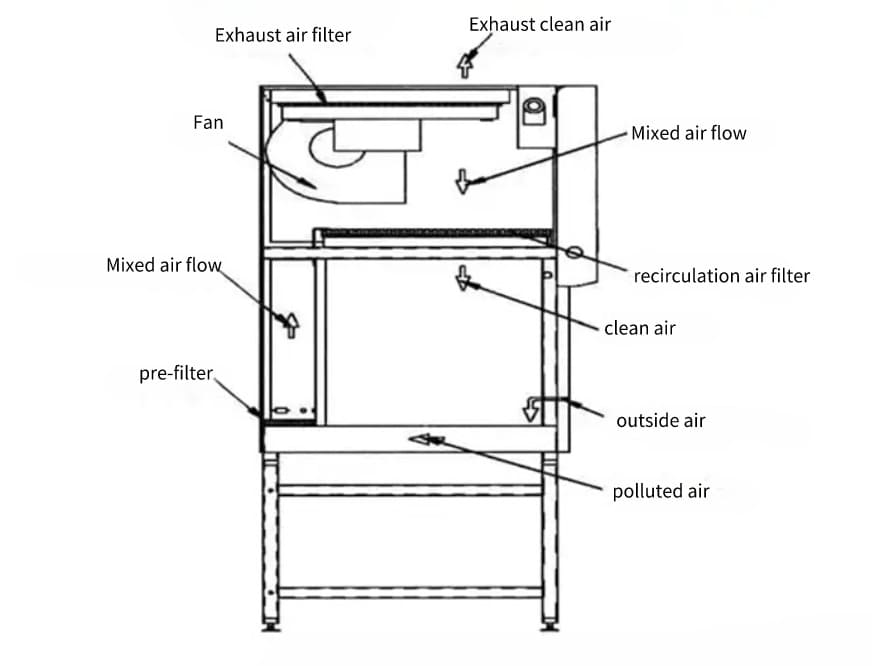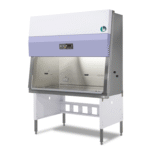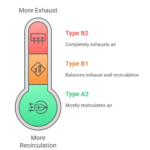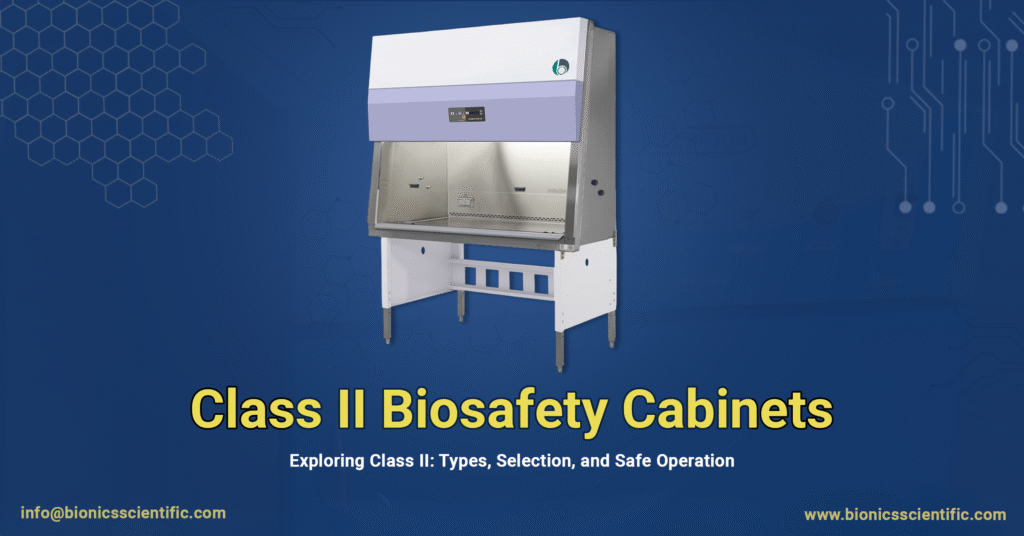In any laboratory the first thing which raises the concern is safety. Irrespective whether it is from handling tiny microorganisms to growing cell cultures to testing new drug compounds and even minute contamination can ruin hours of work and most importantly put people at risk. That is where a Class II Biosafety Cabinet also known as BSC comes in.It helps create a cleaner and safer space so scientists can focus on discoveries without worrying about accidents also contamination.
- What is a Biological Safety Cabinet?
- Why Class II Biosafety Cabinets Are the Lab Standard
- Key Features of Class II BSCs:
- Types of Class II Biosafety Cabinets
- Comparing Class II and Class III Biosafety Cabinets: Which One to go for?
- Operating a Class II BSC: Essential Safety Practices
- Types of Biological Safety Cabinets: Summary
- Choosing the Right Biosafety Cabinet
- Conclusion
- Biosafety Cabinet Video By bionicsscientific
Class II Biosafety Cabinets are the most common choice in laboratories worldwide. They are designed to create a safe workspace by protecting the scientist, the samples being tested and even the surrounding environment all at the same time.
This guide covers everything essential about the Class II Biosafety Cabinet from its working principle and types to a comparison with Class III cabinets. It also highlights key features, maintenance practices and practical tips to help select the right model for any laboratory.
Class II Biosafety Cabinets | Bionics Scientific
ISO-certified and CE marked Bionics Scientific delivers Class II Biosafety Cabinets trusted by top institutions.

What is a Biological Safety Cabinet?
A Biological Safety Cabinet: Sometimes called a bio safety cabinet or bio cabinet is a ventilated enclosed workspace designed to handle biohazardous materials safely. By using HEPA filters and controlled airflow, it ensures a clean and protected environment for lab work. The key protections offered by a BSC include:
- Operator safety: shields personnel from harmful aerosols and pathogens.
- Sample protection: prevents contamination of the materials being handled.
- Environmental safety: keeps hazardous agents from escaping into the lab.
BSCs come in different classes which are Class I, Class II, and Class III each designed for specific lab needs. Among them, Class II Biosafety Cabinets are the most versatile and widely used also offering balanced protection for both the operator and the samples.

Why Class II Biosafety Cabinets Are the Lab Standard
The Class II Biosafety Cabinet is one of the lead choice in many laboratories as it provides three way protection for the operator plus samples and the environment. Its a thoughtful design allows biohazardous materials to be handled safely while keeping the the samples intact..
Key Features of Class II BSCs:
- Filtered vertical airflow: Keeps air clean and with this prevents contamination.
- Adjustable sash window: Lets users access the workspace easily while keeping safety in place.
- Continuous air circulation: Makes sure consistent protection.
- Clean Stainless Steel Interior: Makes cleaning and decontamination quick and hassle free
- Lab Lighting and UV Protection: offers clear visibility.
- Airflow and filter alarms: Alerts operators to potential issues for added safety.
Class II BSCs are widely used across various settings where safety and contamination control are critical:

Applications of Class II Biosafety Cabinets are:
- Microbiology laboratories: for handling bacteria, viruses and other microorganisms.
- Pharmaceutical companies: during drug formulation and testing.
- Vaccine development centers: to safely work with live or attenuated pathogens.
- Hospitals and diagnostic labs: for processing clinical samples.
- Research institutes: supporting diverse scientific experiments safely.
Thanks to their versatility, Class II cabinets serve as the backbone of biosafety in most laboratories, along with providing reliable protection for both personnel and samples.
Looking for a Class II Biosafety Cabinet?
Get a world-class Class II Biosafety Cabinet from Bionics Scientific, a leading Indian manufacturer.
Contact Us for Specs & Pricing: 📞 +91 9111161955 | ✉️ info@bionicsscientific.com
Types of Class II Biosafety Cabinets
Class II BSCs are further classified based on their airflow design:
| Type | Airflow | Application |
| Type A2 | ~70% air recirculated, ~30% exhausted | General microbiology and molecular biology labs |
| Type B1 | More exhaust than recirculation | Handling small amounts of chemicals along with biological agents |
| Type B2 | 100% exhaust and no recirculation | Work with toxic chemicals, volatile agents or high risk pathogens |
Because of their versatility, these cabinets are often called Class II BSCs, Class II Biological Safety Cabinets, or simply biosafety cabinets Class 2..
Comparing Class II and Class III Biosafety Cabinets: Which One to go for?
While Class II Biosafety Cabinets are the most commonly used, certain laboratories require the higher level of protection provided by Class III Cabinets.
- Class II BSC: Ideal for Biosafety Level 2 and 3 labs which offers three way protection for the operator, the samples and the environment.
- Class III BSC: A fully gas tight enclosure designed for maximum protection which is used in Biosafety Level 4 labs where deadly viruses and highly infectious agents are handled.
For laboratories working with high risk pathogens it becomes important to understand the differences between Class II and Class III BSCs as it is crucial before making a purchase decision.
How a Class II Biosafety Cabinet Works: Working Principle Explained
A Class II Biosafety Cabinet keeps both people and samples safe by using a smart there are three step airflow system:
- Inflow Air:Room air is drawn in, preventing contaminants from escaping into the lab.
- Downflow Air: HEPA filtered air gently flows downward which keeps the samples safe from contamination.
- Exhaust Air: In Type A2, some air is recirculated while in Type B2. it is all vented outside the lab.
This rationally designed airflow system is what makes it stand out Class II BSCs reliable and widely trusted in laboratories around the world.
Biological Safety Cabinet Price: What to Expect
One of the most common questions before purchasing arises is How much does a biological safety cabinet can cost? The answer depends on a few key factors:
- Cabinet type: Class I, Class II or Class III
- Dimension and Size: Larger units usually cost more.
- Filter technology: Standard HEPA vs. higher grade ULPA filters
- Brand: Well known names like ESCO often come at a premium
- Additional features: Alarms, UV sterilization and energy saving options can hike the price
Overall, biological safety cabinets are available in a wide price range from budget friendly models for routine lab work to high end units packed with advanced safety and performance features.
Operating a Class II BSC: Essential Safety Practices
To get the best performance and safety from Class II biosafety cabinet, follow these rules:
- Keep the class II cabinet sash at the recommended height.
- Minimize clutter inside the work area.
- Always clean with disinfectant before and after every use.
- Place sterile materials in the center and waste items at the sides.
- Avoid blocking the airflow grills.
- Never use open flames inside a cabinet biosafety system.
- Get annual certification for Class II BSC.
These best practices for biosafety cabinet class II ensure long lasting safety and compliance.
Types of Biological Safety Cabinets: Summary
To recap all the types of biological safety cabinet are:
- Class I: Protects operator and environment only.
- Class II BSC : Protects operator, product and environment.
- Class III Biosafety Cabinet : Maximum protection generally used for deadly pathogens.
Among these the biological safety cabinet class II is the best balance between safety and usability which makes it the most purchased model worldwide.
Choosing the Right Biosafety Cabinet
When selecting a biosafety cabinet class 2 following points should be kept in mind:
- Type A2, B1 or B2 depending on lab work
- Compliance with safety standards like NSF,ANSI and ISO
- Maintenance and filter replacement schedules
- Budget and overall biological safety cabinet price



Conclusion
A Class II Biosafety Cabinet is the most important tool for ensuring laboratory safety. It protects the operator, the environment and the product simultaneously. By understanding biosafety cabinet types, its proper usage practices and price factors the labs can choose the right equipment with confidence.
Whether call it a bio safety cabinet, biological safety cabinet class 2 or simply a class II cabinet. This equipment is an investment in both safety and quality.
For advanced research, high risk environments or compliance needs the one should always consult experts before selecting between a class II biosafety cabinet and a biosafety cabinet class III.
Looking for a Class II Biosafety Cabinet?
Get a world-class Class II Biosafety Cabinet from Bionics Scientific, a leading Indian manufacturer.
Contact Us for Specs & Pricing: 📞 +91 9111161955 | ✉️ info@bionicsscientific.com
FAQs on Bionics Scientific Class II Biosafety Cabinet
Q1. What is a Class II Biosafety Cabinet?

Class II Biosafety Cabinet is a ventilated enclosure that protects the operator, the samples and the environment from contamination.
Q2. Why are Class II Biosafety Cabinets the most common?
Because they strike the right balance between safety, usability and cost. Class II cabinets provide three way protection while being easier to maintain than Class III units.
Q3. What is the difference between Class II and Class III Biosafety Cabinets?
Class II cabinets are suitable for most BSL 2 and BSL 3 labs. Class III cabinets, on the other hand they are fully gastight and used in BSL 4 labs for handling deadly pathogens.
Q4. How does a Class II BSC work?
It works through controlled airflow: HEPA filtered inflow protects the lab, downflow protects samples and exhaust air is either recirculated A2 or vented outside B2.
Q5. What types of Class II Biosafety Cabinets exist?

There are three main types:
Type A2: 70% recirculated, 30% exhausted
Type B1: More exhaust than recirculation
Type B2: 100% exhaust, no recirculation
Q6. How much does a Biological Safety Cabinet can cost?
The cost generally varies based on the type Class I, II or III size along with its features and brand. For example: an ESCO biosafety cabinet may be priced higher but is valued for its reliability and long lasting performance.
Q7. Which laboratories use Class II Biosafety Cabinets?
They are widely used in hospitals, diagnostic labs, pharmaceutical, vaccine centers and microbiology research institutes.
Q8. What safety rules should be followed in a Class II Cabinet?
In order to ensure safety the one should Keep air grills clear, do not overload the workspace also set the sash to the correct height and always disinfect before and after use.
Q9. Can a Biosafety Cabinet handle chemicals?
Yes, but only specific types. Class II B1 and B2 models can safely handle small amounts of volatile chemicals.
Biosafety Cabinet Video By bionicsscientific
Looking for a Class II Biosafety Cabinet?
Get a world-class Class II Biosafety Cabinet from Bionics Scientific, a leading Indian manufacturer.
Contact Us for Specs & Pricing: 📞 +91 9111161955 | ✉️ info@bionicsscientific.com

